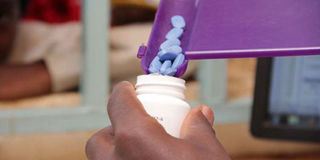Why Kenya cannot pay lip service to healthcare any more

A pharmacist puts medicine inside a bottle. PHOTO | JOSEPH KANYI | NATION MEDIA GROUP
What you need to know:
- HIV prevalence rate has recently stabilised at 5.6 per cent, making it much less of plague than it was in 1999 when up to 40 per cent were thought to be infected in some communities and President Moi declared it a national disaster.
Mass distribution of insecticide-treated mosquito nets has significantly cut malaria deaths, especially among children under five.
- Although Kenya is still ranked 15th among the 22 high TB burden countries in the world, it has put more patients on therapy and boasts one of the best treatment success rates.
Kenyan officials attending the Tokyo International Conference on African Development (Ticad) VI Summit will most likely ask for increased foreign funding to help ease the country’s disease burden.
Of course, they do have a strong case – considering the relative success of national control programmes for malaria, HIV/Aids, and TB.
The HIV prevalence rate has recently stabilised at 5.6 per cent, making it much less of plague than it was in 1999 when up to 40 per cent were thought to be infected in some communities and President Moi declared it a national disaster.
Mass distribution of insecticide-treated mosquito nets has significantly cut malaria deaths, especially among children under five.
And although Kenya is still ranked 15th among the 22 high TB burden countries in the world, it has put more patients on therapy and boasts one of the best treatment success rates.
But the elephant in the room at Ticad will be the fact that Kenya has been precariously relying on foreign aid to keep her citizens healthy.
A 2015 study by the advocacy group Results UK and the local health lobby Kanco found that 45 per cent of the health budget in Kenya is financed by donors.
THEIR WAR
The war against the second leading killer, HIV/Aids, is pretty much their war, with the donors picking the tab for 70 per cent of the health budget.
For all the gains registered in the fight against TB, it remains largely underfinanced with the government putting in only 23 per cent of the needed funds and donors coming through with 17 per cent.
A 60 per cent funding gap says a lot about the fact that Kenya contributes 80 per cent of the global TB.
There are no prizes for guessing why it is dangerous to put a nation’s public health at the mercy of foreigners.
A geopolitical earthquake in some part of the world, like the recent Brexit, could easily see a benefactor review its aid terms or even cut it.
A financial crisis of the scale that hit the rich countries in 2007 and 2008 will almost always force some form of austerity in which foreign aid is among the low-hanging fruits.
It turns out even the country’s better economic fortunes can be a problem!
According to the Results UK / Kanco study, Kenya will in the next three to five years begin to find it more difficult to access official development assistance in light of its new status as a lower-middle income country.
Organisations like the Global Fund to Fight AIDS, Tuberculosis and Malaria are expected to demand increased contributions from Kenya.
We didn’t have to get here though. In 2001, Kenya was among African countries that committed to allocate 15 per cent of their annual budgets to health by 2015. Fifteen years and a Constitution that guarantees quality healthcare to every citizen later, the health allocation stands at only 6.3 per cent.
[email protected]; @otienootieno





